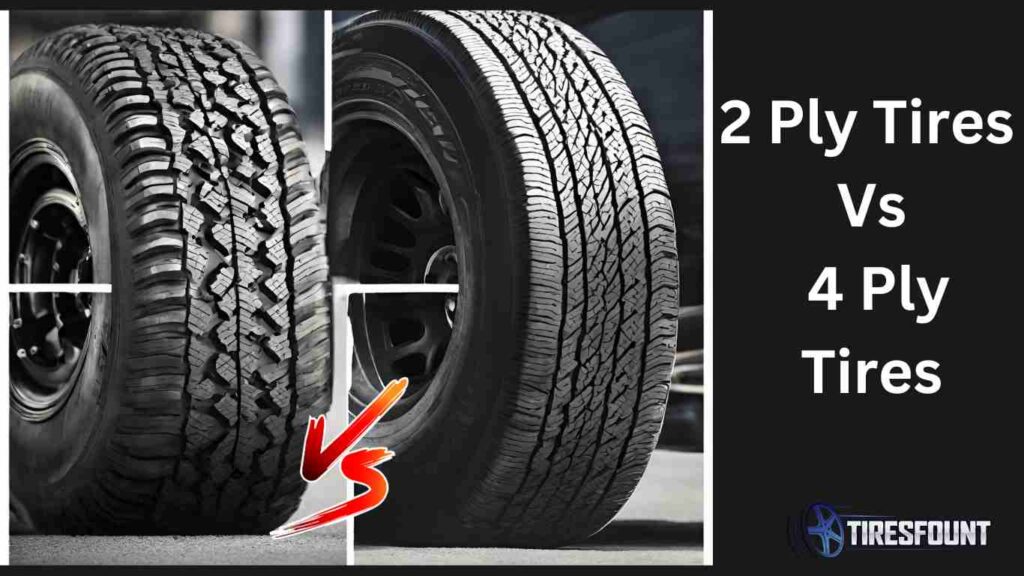Four-ply tires differ from two-ply tires in terms of durability, performance, and construction.
Essentially, 4 ply tires are stronger and more durable than their 2 ply counterparts due to the additional layers of material.
In terms of differences, 2 ply tires are generally lighter and more suited for standard road use.
On the other hand, 4 ply tires, with their extra layers, provide better resistance to punctures and wear, making them ideal for heavier vehicles or rough terrains.
In the following sections of this article, I will explore these differences in greater detail, providing you with comprehensive knowledge on the subject.

2 Ply Tires Vs 4 Ply Tires: An Overview
Here is a table that will bring out all the main differences between these two tire types. But remember, based on the tire manufacturer, the difference might change slightly. Must Check our 4 Ply vs 10 Ply Comparison.
| Features | 2 Ply Tires | 4 Ply Tires |
| Strength/Durability | Less Durable | More durable |
| Load Capacity | Since they aren’t as strong or durable, 2 ply tires generally have a lower load capacity. | 4 ply tires tend to have a higher load capacity. |
| Flexibility | 2 ply tires are more flexible | In comparison, 4 ply tires are less flexible |
| Stability and Handling | Lesser stability while driving due to fewer layers. | Better stability and improved handling due to their stronger build. |
| Ride Comfort | They generally provide smooth ride comfort | Less smooth ride compared to 2 ply tires |
| Cost | 2 ply tires are less expensive | 4 ply tires are normally more expensive |
| Fuel Efficiency | 2 ply tires can potentially offer better fuel efficiency. | 4 Ply tires slightly decrease fuel efficiency. |
You must know the differences in detail to decide on the tire for your next tire change. Here is the detail.
Strength/Durability
So, when we talk about 2 ply tires and 4 ply tires, think about them flashlights. More layers or ‘plies’ are like adding more batteries. The 2 ply ones have fewer layers, making them not as tough as their 4 ply buddies.
Imagine taking a hike in the dark – you’d want the flashlight with more batteries, right?
Same philosophy with tires; more layers or plies usually mean they’re more hearty and can withstand more.
Load Capacity
Now, this is about how much weight the tires can handle. Think of it like backpacks.
A 2 ply tire is like a school backpack – it’s great for books and lunchboxes, but you wouldn’t want to stuff it with rocks.
A 4 ply tire is like a hiking backpack – it’s designed for heavy-duty stuff.
Flexibility
The flexibility of these tires goes like this – 2 ply tires are like yoga instructors, they flex and bend with the road better, giving you a smoother ride on bumpy terrain. 4-ply tires are more like bodybuilders, less flexible but more robust and good at carrying heavier loads while giving a more controlled ride.
Stability and Handling
You know when you’re driving at high speeds and you want your car to feel sturdy and stable?
That’s where 4 ply tires excel; they’re like seasoned surfers riding big waves.
But if you’re cruising at moderate speeds or around the city mostly, 2-ply tires can do the job just fine – they’re like your casual beach swimmer.
Ride Comfort
This one’s pretty straightforward – fewer layers mean more flexibility and smoother rides in most cases.
It’s like choosing between a stiff leather jacket (4 ply) and a soft, comfy hoodie (2 ply).
Cost
Naturally, as with most things, more layers mean more moolah – 4 ply tires usually come with a heftier price tag due to the materials and effort involved in making them.
2 ply tires, on the other hand, are usually more friendly on the wallet.
Fuel Efficiency
Finally, when it comes to fuel efficiency, 2 ply tires are like light runners – they don’t require much energy (or fuel in this case) to do their job.
However, heavier 4 ply tires might make your engine work a little harder due to their weight, affecting your fuel efficiency slightly.
Can You Use Them Interchangeably?

While technically possible, using 2 ply and 4 ply tires interchangeably is not advisable.
Tire ply rating impacts multiple features of vehicle performance, including load-bearing capacity, driving stability, ride comfort, and more.
Mixing different ply rating tires can disrupt the harmony of your ride, causing uneven wear, poor handling, or even safety issues.
It’s always best to stick with your vehicle manufacturer’s recommendations when choosing tires.
If you want to change, ensure that all tires are the same ply. It helps to speak with a tire expert or professional mechanic to select the correct tires for your vehicle’s specific needs.
Final Lines
The choice between 2 ply and 4 ply tires hinges on the specific needs of your vehicle.
For lighter vehicles like sedans and everyday commuters, 2 ply tires may suffice, offering a smoother ride and better fuel efficiency.
On the other hand, 4 ply tires are better suited for heavier vehicles such as trucks and SUVs, providing enhanced durability and load-bearing capacity for off-road adventures or towing purposes.
Tires should be selected according to your vehicle’s requirements in order to ensure optimal performance and safety.
Check our Othersr PLY comparison below.
